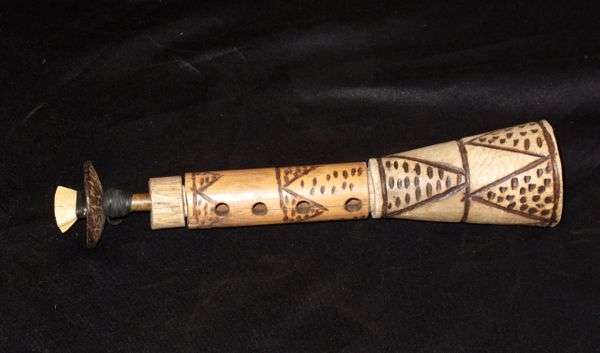Description
The "Nzumari" is a traditional musical instrument from the Swahili culture, primarily found in coastal regions of East Africa, including Kenya, Tanzania, and parts of Somalia. It is also known as "Nzumari wa Kiasili" in Swahili, which translates to "indigenous violin." The Nzumari consists of a hollowed-out coconut shell or gourd, which serves as its resonating chamber. Attached to this chamber is a wooden neck, usually carved from a piece of hardwood. The neck features one or more strings, traditionally made from animal gut or plant fibers, which are stretched from the base of the neck to a peg at the top, allowing for tuning adjustments. To play the Nzumari, the musician holds it upright, similar to how one would hold a violin. The strings are plucked or bowed with a horsehair bow, producing melodic tones. The player typically uses their fingers to stop the strings at various points along the neck to change the pitch, similar to fretting on a guitar.The sound of the Nzumari is characterized by its warm, resonant tones, which can vary in pitch depending on the length and tension of the strings. Traditionally, the Nzumari was used to accompany storytelling, dance, and other cultural performances, adding a distinctive musical texture to the festivities. The Nzumari holds cultural significance in Swahili communities, where it is considered a symbol of tradition and heritage. It has been used for generations in various cultural rituals, ceremonies, and celebrations, serving as a means of cultural expression and entertainment. While the Nzumari has historical roots, its use has somewhat declined in contemporary times, particularly with the introduction of Western musical instruments and influences. However, efforts are being made to preserve and promote traditional instruments like the Nzumari as part of cultural revitalization initiatives in East Africa.




